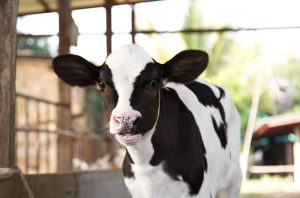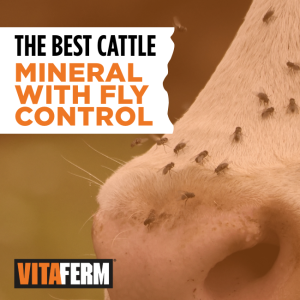Spring might seem like an eternity away. Across the U.S., temperatures have dipped well below zero, and there’s a blanket of snow over most of the country.
However, spring is on the way. With its arrival, cattle producers will be thinking about turning their cattle out on nice green pastures. Spring grazing is always an exciting time, but before you turn out those pairs to green grass, consider a hidden concern of grazing.
Eating right is important for cattle during spring and early summer grazing when there is an excess of potassium in their forage. This is when producers are most likely to have to contend with Grass Tetany. Fortunately, with proper management and care, you can prevent grass tetany. That’s according to Chris Cassady, Ph.D., Director of Beef Technical Sales for BioZyme® Inc.
Defining Grass Tetany
Sometimes known as grass staggers, grass tetany often first impacts your cattle’s coordination. When cattle become susceptible, they start to stagger around and will go down on their side.
“Most producers think of tetany as a magnesium deficiency because feed companies use magnesium to prevent occurrence, but really it is excessive intake of potassium. Potassium and magnesium compete for the same absorption pathway,” Cassady said.
“Think of the absorption pathway like a funnel. Three potassium marbles are trying to get through the funnel at the same time as one magnesium marble. Since the percentage of potassium marbles is greater, that nutrient is more likely to go down the funnel and get absorbed before the magnesium does.”
Tetany typically occurs in older animals rather than younger animals because of an inability to mobilize the magnesium from the bones. Mature cows will show signs long before a young calf.
What Causes Grass Tetany?
Most of the time tetany will happen when cattle are on lush forage. While transitioning from winter to spring, nutrients, including potassium, rise up from the ground through the roots to support grass growth. When there are a few weeks of warm weather, those nutrients go to the plant that is above ground, actively growing.
But if a cold snap or cool weather sets in, growth pauses, but those nutrients continue to accumulate in the plant. With those warm weather/cold weather cycles, the potassium levels can potentially become twice the amount they normally are. This leads to tetany challenges when you turn your cows out in the spring.
Since tetany is a nutritional issue, it isn’t isolated to just the spring and summer when we turn cattle out to grass; it can also happen while feeding hay. In that case, we have what might be referred to as “winter tetany” or “wheat pasture poisoning” when cattle consume harvested winter feeds high in potassium. In that case, you should have your forages tested.
Tetany is a global issue and impacts all ruminants that have an improper potassium-to-magnesium ratio. Most regions don’t have problems with tetany in the fall. However, it can be an issue especially if producers fertilize.
“Nitrogen absorption also blocks the absorption of magnesium, so if you fertilize your pastures, it’s basically a one-two punch for magnesium interference. Remember, a rule of thumb is that your potassium to magnesium ratio should probably be 10:1 or less,” Cassady reminds.
Preventing and Treating Grass Tetany
There is no perfect mineral for preventing grass tetany. However, feeding a high-mag mineral during the high-risk periods—namely, the spring and fall growing seasons—will prevent the vast majority of issues. BioZyme offers mineral options that can help.
VitaFerm® Concept•Aid® Mag/S
The first mineral that Cassady recommends for cattle producers with high-potassium forages is VitaFerm® Concept•Aid® Mag/S. This premium free-choice 5% phosphorus vitamin and mineral supplement with elevated magnesium for beef cattle is designed to support reproductive success when grass tetany is possible.
Like all VitaFerm products, it contains AO-Biotics® Amaferm®, a prebiotic research-proven to enhance digestibility. It also contains magnesium which helps prevent grass tetany.
Additionally, this product includes organic copper, iodine and zinc for maximum bioavailability, innate immunity and hoof health. It also includes high levels of Vitamin E to support reproductive tract repair and milk quality.
VitaFerm Conserve® Mag
VitaFerm Conserve® Mag is a free-choice vitamin and mineral supplement for beef cattle with elevated magnesium. It’s ingredients support herd health and performance while minimizing cost.
It also contains Amaferm, a prebiotic research-proven to enhance digestibility, and magnesium helps prevent grass tetany. Conserve features a complete but economical vitamin and mineral package.
How to Feed your High-mag Supplement
Start increasing magnesium levels about three weeks before turning out to pasture so you can gauge how much the cow might eat when turned out on grass. Remove all other sources of salt so that forces the cows to get salt from the mineral. The bitterness of higher magnesium could restrict intake to less than the recommended amounts. Or, you might have to force-feed the magnesium in a grain mixture if the cows won’t eat the free-choice mineral.
Plan B
When a high-magnesium mineral doesn’t work, a second possible option for prevention is dilution.
“Why is it sometimes that high-mag mineral fails? With any free-choice mineral, especially with a bitter ingredient like magnesium, you might not be able to get a cow to eat enough mineral. That means you will struggle to fix the ratio.”
“If the potassium is in excessive levels, lock them away from lush forages and offer them a bale of grass hay in a lot. Restrict their forage consumption to four to six hours per day to dilute intake of high potassium forage,” Cassady said.
Remember to check your cattle regularly when they are first turned out to new, green grass. Grass tetany is treatable when detected early. Call your veterinarian at the first signs of any tetany. The vet will typically provide an intravenous solution of calcium, magnesium and glucose to get the cow back on her feet. Timing is critical though, as cows will likely die if not treated within 4-8 hours after onset.
Is Prevention a Cost or Investment?
Grass tetany doesn’t happen in every part of the country or every year. However, if you are a cow-calf producer who has ever dealt with tetany or excess potassium, a high-mag mineral program is an excellent investment. In fact, two producers in the same county could have forages with different nutrient levels in any given year.
“Potassium in large amounts is deadly, so tetany does have a big impact. That is why magnesium for someone who has lost an animal in the past becomes like an insurance policy,” Cassady said.
The VitaFerm Concept•Aid Mag/S compared to VitaFerm Concept•Aid 5/S is about two cents more per day to feed. And a producer will typically only feed increased amounts of magnesium for 60 days, so for $1.20 per cow annually. For less than a large, iced tea at McDonald’s you can provide your cows with the added nutrition they need to help prevent grass tetany.
“If you save one cow from grass tetany every two years, you will more than break even to feed our Mag mineral to a herd of 100 cows every year. Considering it costs roughly $2,500 to replace a cow, and her calf could bring at least $1,500 at weaning, depending on your market conditions, that’s a pretty good investment in her health,” Cassady said.
As with all health challenges, the key to preventing tetany is to provide the proper amounts of all nutrients. If you can keep your magnesium-to-potassium ratio in check, your cows should enjoy grazing green grass and stay healthy. A product like the VitaFerm Concept•Aid Mag/S will provide balanced nutrients and prepare your herd for reproductive readiness.
BioZyme Offers Products for Year-Round Nutrition
Not only does BioZyme make high-mag supplements to alleviate grass tetany, but it also makes many products for reproductive success. These include VitaFerm Concept•Aid and VitaFerm Conserve lines. To find a VitaFerm product that best fits your operation and management scenario, check out our Product Navigator.
Here’s What our Customer’s Say. . .
In Illinois
“The High Mag option in the VitaFerm Concept•Aid line is one we use heavily this time of year to protect against the risk of grass tetany. We feel it is a vital tool for our program. We have used other minerals in the past but have not experienced the same kind of results we have now with Concept•Aid.”
“Our conception rates have increased dramatically in both our A.I. and embryo transfer programs, and for an operation like ours that relies heavily on E.T. work – our conception rates represent the difference between losing money and being profitable.” – Ryan Schlipf, Tree Lane Farm
In Nebraska
“We were losing calves left and right during calving season. The vets were helping us out with all of the new medication that they could think of. It slowed the pneumonia down, but it didn’t stop it. We were at a loss, then I started thinking. I had been to a meeting where VitaFerm was talking about their products. I contacted my friend, who was a local dealer, and told her what was going on. She suggested the VitaFerm loose mineral Concept•Aid® Mag/S.”
“When I placed out the loose mineral with salt, the cows and heifers started eating it up. When the calves saw this, they started eating. I was putting mineral out left and right because they were cleaning it up. After about two weeks they slowed down. In that time frame we started losing fewer and fewer calves.” – Paula Brown
Be Proactive in your Grass Tetany Prevention
You can proactively prevent grass tetany by ordering your VitaFerm Concept•Aid Mag/S today. You can find BioZyme dealers all across the U.S. They are always happy to help put a stop to problems before they start.
Want more information about cattle production or our line of vitamins and minerals? Sign up for our monthly e-newsletter.


